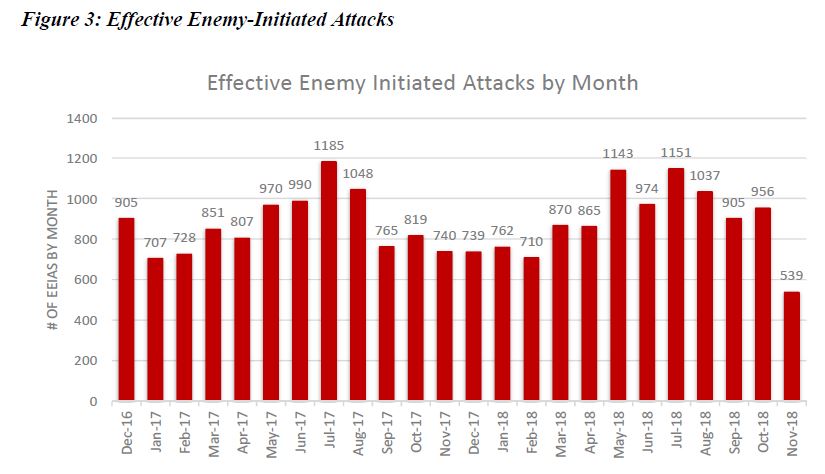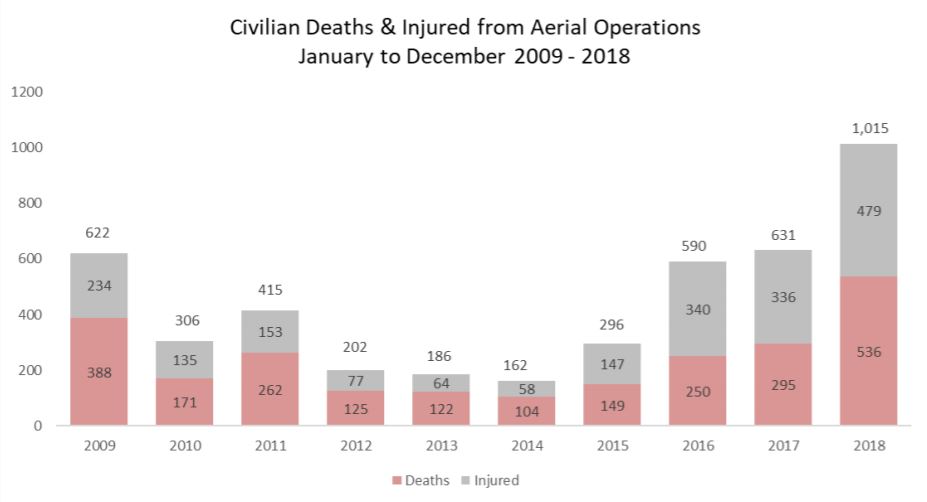U.S. Marines departing from Helmand province from Camp Bastion, October 27, 2014. – Image released by the US Marine Corps, Wikimedia Commons.
“We will not waver. We will not tire. We will not falter. And we will not fail. Peace and freedom will prevail.” – Former President George W. Bush announcing the beginning of the invasion of Afghanistan.
It is hard to imagine that anyone in Washington or any American alive at the time anticipated that the war in Afghanistan would become the bloodiest American conflict of the 21st Century, the longest in its history and lead to an outcome today that no one can declare as a victory. The current peace negotiations, with the goal of ending a civil conflict that has claimed and displaced the lives of thousands, are the longest and most substantive between the U.S. and the Taliban. Yet the path forward is still uncertain, with the details of the agreement to be determined and the long-term consequences of a ceasefire being fiercely debated.
President Trump’s appointment of former U.S. ambassador to the United Nations, Zalmay Khalilzad, as Special Representative for Afghanistan Reconciliation in September 2018 was widely regarded as a signal of renewed commitment to seeking an end of U.S. involvement. Khalilzad’s diplomatic efforts have yielded the most significant sequence of peace negotiations in the conflict’s 17-year history. On January 28, a framework was agreed upon by which the Taliban would guarantee to never harbor or allow for terrorist networks to operate from within the country, which could pave the way for larger concessions in the future in return for a withdrawal of U.S. troops. Nevertheless, the framework suffers from a lack of concrete details, including but not limited to enforcement mechanisms, the security of civil and political rights progress and greater uncertainty over how far the Taliban is willing to go to attain their chief priority — full U.S. withdrawal.
How Have We Gotten Here? A Brief History of the Afghanistan Conflict
In 2001, a U.S.-led international coalition invaded Afghanistan, which was under Taliban rule, as part of the Bush administration’s broader retaliation against Al-Qaeda for its role in the 9/11 attacks. Military resistance quickly collapsed, and coalition forces were faced with the now insurmountable task of rebuilding and governing the fragmented country. Issues of corruption, inefficient state-building practices and continued Taliban insurgency have led to overall mixed results in the reconstruction of the country. The proven resilience of the Taliban following the collapse of its formal government in December 2001 has led to persistent cycles of violence and demanded the constant attention of U.S. forces to help the Afghan government and security forces to be established.
Figure 1: From the Department of Defense

Since the beginning of operations in 2001, “1,881 U.S military personnel have been killed in action (KIA) and 2,401 have been wounded in action (WIA) as of November 30, 2018” according to a Department of Defense annual report published in December 2018. The persistent violence has also exacted a costly, deadly price on civilians with nearly 70,000 recorded civilian casualties and nearly 25,000 being killed since 2001 according to the United Nations, primarily from indiscriminate weapons (e.g., suicide bombs, IEDs) but also coalition airstrikes.
Regardless of Washington’s desperate belief that an end is in sight, there is no refuting the complex, stubborn nature of the conflict, defying the efforts of three administrations and the military top brass. Even after years of fighting, the Taliban has maintained operational integrity and has displayed a continued ability to organize mass offensives to challenge the Afghan government’s control of various provinces, in no-fault due to Pakistan’s role in supplying and sustaining the Taliban. In 2018, the SIGAR (Special Inspector General for Afghanistan Reconstruction) report described the conflict as a stalemate with Afghan government territorial control at its lowest point since 2015 and nearly 32% of provinces listed as contested. Recently, the Afghan National Defense and Security Forces (ANDSF) have faced a deficiency of manpower after having suffered heavy casualties and lower reenlistment rates.
The uptick in violence due to renewed Taliban offensives on major population centers, high-profile assassinations and continued vicious assaults against Afghan bases around the country were largely attributed to efforts to gain bargaining leverage in ongoing negotiations. The U.S. and coalition forces have responded similarly with increased airstrikes and special operations missions to apply pressure during peace talks. Combined with relaxed rules of engagement, the increased operations have been reflected in the increasing humanitarian toll. The number of civilians injured or killed by aerial operations is at its highest since before 2009, according to a UN report.
Figure 2: From the UNAMA Quarterly Report:

Going Forward: Players for Peace
Amid the increased violence, peace negotiations have pressed forward with the United States and Taliban conducting a series of talks in Doha, Qatar in January which have continued today. As of now, each side has a particular set of demands:
- The United States of America, represented by Zalmay Khalilzad seeks, first and foremost, the guarantee that Afghan territory will never be used for terrorist activities. Other concerns include preserving civil society gains and rights for women. In the immediate, it hopes to pressure the Taliban into conducting talks directly with the Afghan government to negotiate a ceasefire.
- The Islamic Emirate of Afghanistan (Taliban), represented by Mullah Abdul Ghani Baradar, seeks a full withdrawal of all foreign forces, especially U.S. troops. The Taliban refuse to negotiate directly with the Afghan government as it is considered a puppet installed by the West.
- The Islamic Republic of Afghanistan seeks a peaceful resolution but has largely been frustrated over its lack of involvement in talks. It has made an effort to appeal to the U.S. to slow its withdraw, fearing a hasty U.S. withdrawal would be disastrous and that the agreements by the Taliban will not be acceptable.
Better Late Than Never? Uncertainty and Concerns
Given the rapid progression of negotiations in the closing months of 2018 until now, there have been a variety of assessments and debates over the actual details of what should be included in a final deal and concerns over the consequences of a U.S. withdrawal.
First and foremost, one of the most pressing questions concerns enforcement mechanisms, as the Taliban’s assurances to uphold the agreement is tenuous at best, given its record of allowing terrorist activity within its borders and past promises reneged.
According to Professor Michaela Mattes, Associate Professor of Political Science at UC Berkeley who specializes in international conflict and peace agreements, “It’s not even that the troops could leave once there is a peace deal. We know in the literature that the single most important factor to upholding a peace accord is enforcement. Peacekeeping troops which can be either the UN or other countries’ troops, in this case, NATO or U.S. troops are crucial to it [(the peace accord)].”
Enforcement is problematic because of the stance of the U.S. and its allies, who want to resolve the conflict and withdraw. Specifically, the Trump Administration’s tendency to abdicate international commitments combined with a war-weary domestic opinion toward the war means that the U.S. is unlikely to return if it ever leaves. Therefore, enforcement either depends on the U.S. enacting a prolonged withdrawal, which has been ill-received by Taliban fighters but deemed necessary to prevent the Afghan security apparatus from fracturing, or another third-party maintaining a military presence after the U.S. leaves. The prospect of an extended withdrawal timeline brings into question the standards the U.S. would use to determine whether to fully withdrawal and the potential for a prolonged, indefinite commitment of troops. “In many conflicts, [peacekeeping] troops were there for decades and still are there and once they leave things go to hell,” said Mattes. “So it’s possible that there’s never a time in which the U.S. could withdraw…It could be that it is just an ongoing costly investment.”
Additionally, there are significant concerns about the further deterioration of the greater security environment because of the operational weaknesses and overall incapability of the ANDSF to operate independently.
Since international forces have retreated to a supporting role in 2015, Afghan security forces have struggled to operate independently and have not been able to mount successful offensive campaigns. Defensive operations often require coalition air support yet many rural outposts and military bases have still been overrun forcing the Afghan government to prioritize protecting population centers over holding territory.
“If the U.S. were to pull out completely…I think what we’d see is a probably pretty quick Taliban takeover,” said Seth G. Jones, Senior Adviser to the International Security Program at CSIS, “of some cities in the country, provincial capitals, and ultimately Kabul itself might fall…”

Other concerns have been over the fate of the progress that has been made in civil and political rights, especially for women. The Taliban are notorious for their strict interpretation of Islamic Sharia law, mandating oppressive practices against women during their rule from 1996-2001. As a result, many women civil society groups have emerged in protest of a peace agreement fearing a reversion to their harsh life if the Taliban were to be allowed back into government.
With details of the peace agreement still being decided, there are talks about the creation of an interim transitional government to coordinate elections involving both Afghan and Taliban candidates. Though the creation of a political power-sharing agreement is an attractive option on the surface, corruption has plagued the Afghan government for years and the fact that the Taliban consider the current government a puppet of the West makes it difficult to see if such an arrangement would prove sustainable in the long-term.
President Bush’s assertive, righteous remarks nearly 18 years ago declared the beginning of the War on Terror. However, today, we can see the reality of the U.S. tiring and faltering. Nonetheless, this does not mean peace and freedom are lost. It is evident that a settlement is at its closest point ever, but numerous questions and debates must still be answered, and any agreement will likely be just as complex and tenuous as the war itself.
Featured Image: Wikimedia Commons






Be First to Comment